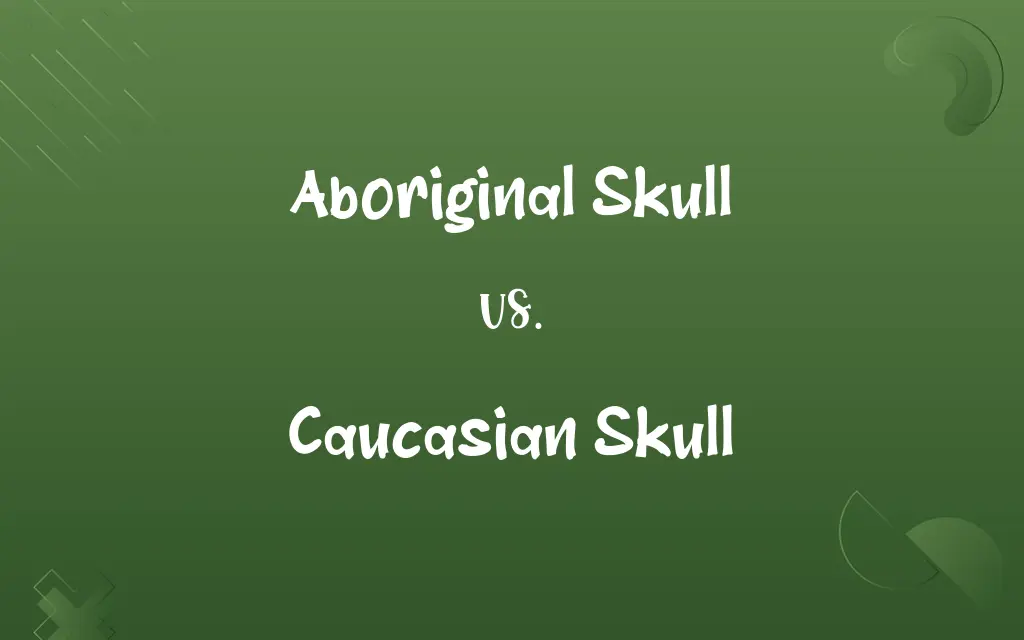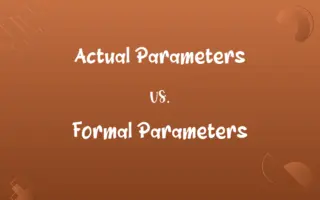Aboriginal Skull vs. Caucasian Skull: Know the Difference

By Shumaila Saeed || Published on February 24, 2024
Aboriginal and Caucasian skulls differ in cranial shape, facial structure, and nasal aperture width, reflecting diverse genetic and evolutionary histories.

Key Differences
The Aboriginal Skull typically exhibits a broader cranial shape with pronounced brow ridges and a longer skull base, indicative of their unique genetic lineage. In contrast, the Caucasian Skull often shows a narrower cranial structure, with less pronounced brow ridges, reflecting different ancestral adaptations.
Shumaila Saeed
Feb 24, 2024
Facial features of the Aboriginal Skull, such as the cheekbones and jawline, tend to be more prominent and angular compared to the Caucasian Skull. The latter often has softer, less pronounced facial contours, a distinction that underscores the diverse evolutionary paths of these groups.
Shumaila Saeed
Feb 24, 2024
The nasal aperture of the Aboriginal Skull is generally wider and more flared, adapted to warmer climates. Conversely, the Caucasian Skull often has a narrower nasal aperture, a trait linked to adaptation in colder environments.
Shumaila Saeed
Feb 24, 2024
The dental structure also varies, with the Aboriginal Skull typically having larger teeth and a more robust dental arch. The Caucasian Skull, on the other hand, often presents smaller teeth and a more parabolic dental arch.
Shumaila Saeed
Feb 24, 2024
Overall, the Aboriginal Skull and Caucasian Skull represent distinct anthropological histories. These differences are not just physical but also reflect the unique cultural and environmental backgrounds of Aboriginal and Caucasian populations.
Shumaila Saeed
Feb 24, 2024
ADVERTISEMENT
Comparison Chart
Dental Structure
Larger teeth, robust dental arch
Smaller teeth, parabolic arch
Shumaila Saeed
Feb 24, 2024
Adaptation Significance
Suited for warmer climates
Suited for colder climates
Shumaila Saeed
Feb 24, 2024
ADVERTISEMENT
Aboriginal Skull and Caucasian Skull Definitions
Aboriginal Skull
It exhibits adaptations to ancient environmental conditions in Australia, like a wider nasal aperture.
The Aboriginal Skull's wider nasal aperture suggests adaptation to Australia's ancient climate.
Shumaila Saeed
Jan 15, 2024
Caucasian Skull
It exhibits less pronounced facial features compared to other ethnic groups, like less angular cheekbones.
The reconstruction from the Caucasian Skull showed softer facial contours.
Shumaila Saeed
Jan 15, 2024
Aboriginal Skull
It represents the physical anthropology of Aboriginal populations, with specific facial and cranial traits.
Anthropologists studied the Aboriginal Skull to understand the evolution of early Australian inhabitants.
Shumaila Saeed
Jan 15, 2024
Caucasian Skull
A Caucasian Skull typically has a narrower cranial shape, reflecting the genetic heritage of European descent.
The forensic team used the narrower cranial shape to identify the remains as a Caucasian Skull.
Shumaila Saeed
Jan 15, 2024
Aboriginal Skull
An Aboriginal Skull is characterized by a broad cranial structure unique to Indigenous Australian ancestry.
The museum displayed an Aboriginal Skull, illustrating the distinct cranial features of Indigenous Australians.
Shumaila Saeed
Jan 15, 2024
ADVERTISEMENT
Caucasian Skull
Its dental structure often presents smaller teeth and a more parabolic dental arch.
Dental examination of the Caucasian Skull revealed smaller, more aligned teeth.
Shumaila Saeed
Jan 15, 2024
Aboriginal Skull
The skull features pronounced brow ridges and a long skull base, typical of Aboriginal genetic lineage.
In the excavation, the Aboriginal Skull was identified by its pronounced brow ridges.
Shumaila Saeed
Jan 15, 2024
Caucasian Skull
The Caucasian Skull represents a blend of various European genetic ancestries and adaptations.
The Caucasian Skull studied in the lab showed a mix of genetic traits common in European populations.
Shumaila Saeed
Jan 15, 2024
Aboriginal Skull
The Aboriginal Skull also has a distinct dental structure, indicative of dietary habits.
Researchers compared the dental structure of the Aboriginal Skull to understand historical diet patterns.
Shumaila Saeed
Jan 15, 2024
Caucasian Skull
The skull is characterized by a narrower nasal aperture, adapted to colder climates of European regions.
The narrower nasal aperture of the Caucasian Skull is a trait evolved from colder European climates.
Shumaila Saeed
Jan 15, 2024
Repeatedly Asked Queries
How do nasal apertures differ between Aboriginal and Caucasian Skulls?
Aboriginal Skulls have wider, more flared nasal apertures, while Caucasian Skulls have narrower nasal apertures.
Shumaila Saeed
Feb 24, 2024
Do these skull differences indicate different environmental adaptations?
Yes, the differences suggest adaptations to different climates, with Aboriginal Skulls adapted to warmer and Caucasian Skulls to colder environments.
Shumaila Saeed
Feb 24, 2024
How do the skull shapes reflect the historical migrations of these groups?
Skull shapes can give clues about historical migrations and adaptations, with broader skulls suggesting different migratory paths and environments.
Shumaila Saeed
Feb 24, 2024
What distinguishes the cranial shape of an Aboriginal Skull from a Caucasian Skull?
The Aboriginal Skull typically has a broader and longer cranial shape, while the Caucasian Skull is narrower and shorter.
Shumaila Saeed
Feb 24, 2024
What are the dental differences between Aboriginal and Caucasian Skulls?
Aboriginal Skulls generally have larger teeth and a more robust dental arch, whereas Caucasian Skulls have smaller teeth and a more parabolic arch.
Shumaila Saeed
Feb 24, 2024
Can skull shape impact brain size or intelligence?
While skull shape can influence brain size, there is no scientific evidence linking it to intelligence.
Shumaila Saeed
Feb 24, 2024
Are there any common misconceptions about these skull types?
A common misconception is that skull shape directly correlates with certain behaviors or abilities, which is not supported by scientific evidence.
Shumaila Saeed
Feb 24, 2024
Is the brow ridge more pronounced in Aboriginal Skulls?
Yes, Aboriginal Skulls typically have more pronounced brow ridges compared to Caucasian Skulls.
Shumaila Saeed
Feb 24, 2024
How do researchers study these different skull types?
Researchers use methods like osteology, 3D scanning, and comparative analysis to study these skulls.
Shumaila Saeed
Feb 24, 2024
Are the facial features different in Aboriginal and Caucasian Skulls?
Yes, Aboriginal Skulls have more prominent, angular facial features, whereas Caucasian Skulls tend to have softer, less pronounced features.
Shumaila Saeed
Feb 24, 2024
Are there any cultural implications of these skull differences?
While skull differences reflect genetic diversity, cultural implications should be approached sensitively, avoiding stereotypes or generalizations.
Shumaila Saeed
Feb 24, 2024
Can genetic studies provide additional insights into these differences?
Yes, genetic studies complement physical anthropology, offering deeper understanding of the ancestral lineages.
Shumaila Saeed
Feb 24, 2024
Can skull features be used to determine ancestry?
Yes, certain cranial and facial features can indicate ancestral lineage, though they should be considered with other anthropological evidence.
Shumaila Saeed
Feb 24, 2024
How do these skull types affect forensic identification?
They provide key physical characteristics that help forensic experts in identifying ethnic background in skeletal remains.
Shumaila Saeed
Feb 24, 2024
How do these skulls contribute to the study of human evolution?
They provide insights into the adaptation, migration, and diversification of human populations over time.
Shumaila Saeed
Feb 24, 2024
Is it possible to accurately reconstruct facial features from these skulls?
Yes, forensic anthropology can reconstruct facial features from skulls, but the accuracy depends on the quality of the skull and the methods used.
Shumaila Saeed
Feb 24, 2024
Can environmental factors besides climate affect skull shape?
Yes, factors like diet, lifestyle, and other ecological variables can influence skull morphology.
Shumaila Saeed
Feb 24, 2024
Are there any evolutionary theories explaining these differences?
Evolutionary theories suggest these differences evolved as adaptations to diverse environments and lifestyles.
Shumaila Saeed
Feb 24, 2024
Are there any ethical considerations in studying these skulls?
Ethical considerations include respecting the cultural and ancestral significance of these remains, particularly in the case of Indigenous populations.
Shumaila Saeed
Feb 24, 2024
How do these skull types help in understanding global human diversity?
They highlight the physical diversity of humans and underscore the rich tapestry of our evolutionary history, demonstrating how different populations have adapted to their unique environments over millennia.
Shumaila Saeed
Feb 24, 2024
Share this page
Link for your blog / website
HTML
Link to share via messenger
About Author
Written by
Shumaila SaeedShumaila Saeed, an expert content creator with 6 years of experience, specializes in distilling complex topics into easily digestible comparisons, shining a light on the nuances that both inform and educate readers with clarity and accuracy.








































































